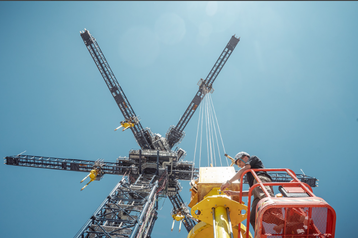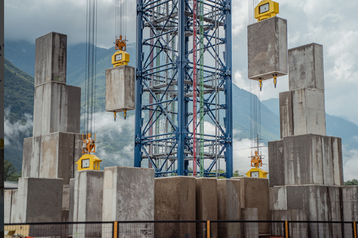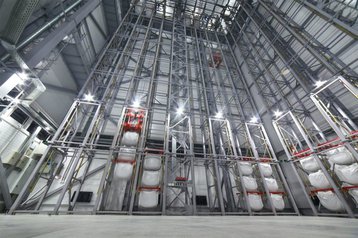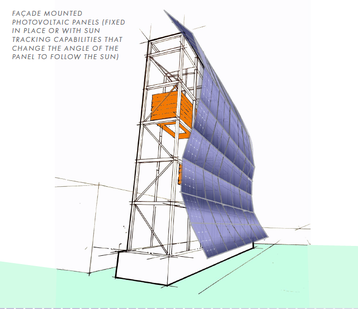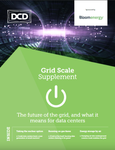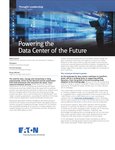The concept of a gravity battery is not new. Grandfather clocks and cuckoo clocks have been ticking away since the 1650s, powered by a weight that drives the mechanism as it falls.
More recently the GravityLight from SolarAid harnessed the same principle to create off-grid light for people in developing countries. Fill a bag with rocks, lift it, and let it drive a dynamo as it falls, creating electricity to produce light.
Large scale gravity storage usually makes use of pumping water uphill and then allowing it to drive a hydoelectric power station. But if you don’t have a large lake available, you could use a crane to raise a concrete block, then recover the potential energy stored, by letting it fall.
It’s an idea that hasn’t been used widely, but as the grid decarbonizes, the world needs to find ways to store the surplus energy produced by renewables in times of sunshine or strong wind, to be used when those renewable resources aren’t available.
There are a few companies with pilot gravity battery projects, and they point to benefits that include a much smaller footprint than pumped hydro, and no requirement for a hilly area.
This article appeared in our Grid Scale Supplement. Read the whole thing here
Giant Swiss Lego
The most striking gravity battery is Energy Vault’s 110m-high system of cranes in the Swiss city of Ticino. It lifts and stacks 35-ton blocks, to store a total of 35MWh of energy.
The blocks are more environmentally friendly than concrete: they’re made from wasted dirt and a special polymer. And the operation is more complicated than you might think: blocks have to accelerate, and then decelerate before they make a landing. Energy Vault’s crane has six arms, so one block can accelerate while another decelerates, CEO Robert Piconi told IEEE Spectrum.
In Scotland, Gravitricity is working on a prototype 250kW system using 50-ton blocks, but it plans to go much bigger, raising and lowering 5,000-ton weights in abandoned mine shafts.
In Russia’s Skolkovo Technopark, Energozapas - backed by one billion roubles ($13bn) - has built a prototype Lifted Weight Storage (LWS) system, basically a set of lifts carrying containers of compressed earth up and down.
The system is 80m tall, and has a capacity of 2.5MWh. If it catches on, the company hopes to build a massive system by 2025, which will be 300m tall, hold 1GWh of energy and deliver it at a rate of 1GW.
Lift Renewable Energy is a startup with an idea reverses the scheme. Buoyant gas containers are held on the bottom of the ocean by a winch which allows them to rise when energy is needed. Lift says the idea can store GWhs of energy, and is space-saving because it doesn’t use any dry land, while most of the population of the world is near enough to the sea to benefit from the energy.
What about data centers?
None of these projects have specifically targeted data centers, but given the importance of data centers to society, and their rapid growth, it’s only a matter of time before one is located near a gravity battery trial.
And in 2020, Canadian architect WZMH actually proposed data centers could invest in their own lift system and concrete blocks, specifically to recover energy wasted when data center generators are tested.
Data center generators are for backup at data centers, as well as at other facilities like hospitals, but they are fired up every month to test them. WZMH says this produces energy which normally goes to waste. With the help of Toronto's Ryerson University, WZMH designed a system to use that energy to raise concrete blocks in an elevator.
The idea is to raise the concrete block during the generator test, then when the block falls, use that energy to charge batteries, which can provide green energy to surrounding buildings.
"This is a concept. It's part of a research and development project we are working on," said WZMH principal Zenon Radewych in an email to DCD. "We believe it has a strong chance of being a product."
Data center power experts contacted by DCD weren’t so sure. For one thing, generator tests rarely go up to full power - and if energy really was being wasted in the amounts suggested by WZMH, then it would be evident in things heating up.
For another thing, WZMH suggests using batteries to store the energy from the raised block. Why raise the block in the first place, when that energy could have been sent straight to the batteries?
And in fact, data centers all have a big room full of batteries already, right next to the generator. If there really is waste energy from the generator, then surely it could be used to charge them up.
If the gravity battery has merits, however, maybe it could fit in as part of the system, between the generator and the batteries, providing a small amount of energy to smooth transitions, much like flywheels.
Gravity batteries in real life
If all this sounds somewhat theoretical, consider this: you can help charge and discharge a gravity battery in real life - every time you use an elevator.
Many commercial lift systems recover some of the energy released by the downward journey, to reduce the energy needed on the upward path. Otis, for instance, says its ReGen system can save up to 30 percent of the electricity used by the lift.
If you walk up the stairs and take the lift down, you’re making a net contribution.

